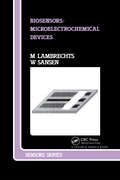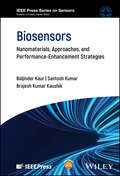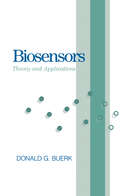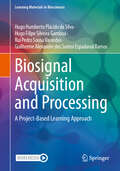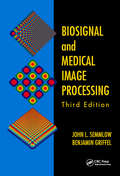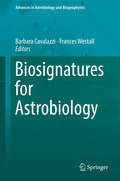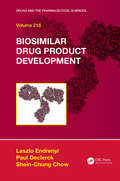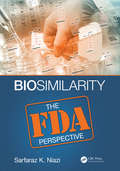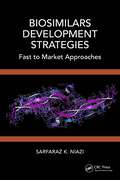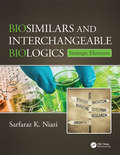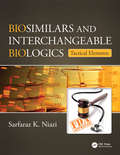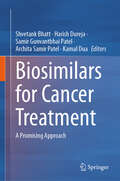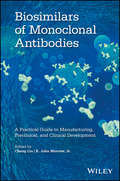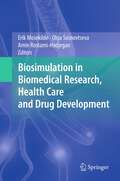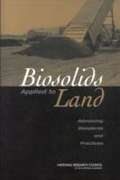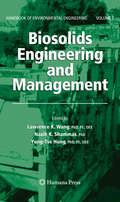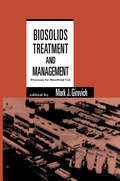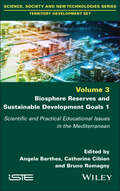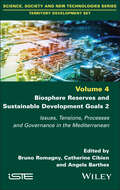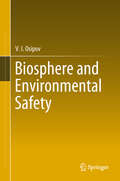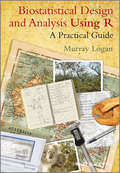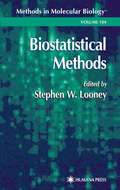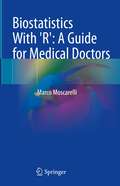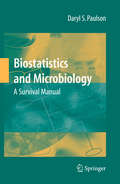- Table View
- List View
Biosensors: Microelectrochemical Devices
by M Lambrechts W SansenBiosensors are analytical devices that combine a biologically sensitive element with a physical or chemical transducer to selectively and quantitatively detect the presence of specific compounds. Balancing basics, principles, and case studies, Biosensors: Microelectrochemical Devices covers the theory and applications of one class of biosensor-microelectrochemical devices. The book clearly explains microelectronic techniques used to produce these cheap, fast reacting, and disposable sensors with the aid of helpful diagrams and tables. Researchers and postgraduates active in the field of chemical sensors, analytical chemistry, or microelectronics will find this an invaluable reference.
Biosensors: Nanomaterials, Approaches, and Performance-Enhancement Strategies (IEEE Press Series on Sensors)
by Brajesh Kumar Kaushik Santosh Kumar Baljinder KaurComprehensive resource covering new technologies, materials, strategies, and recent advancements in the field of biosensing Biosensors summarizes cutting-edge technologies in biosensing, including gene editing (known as Clustered Regularly Interspaced Short Palindromic Repeat or CRISPR), quorum sensing utilizing inter and intra cell signals, two-dimensional (2D) materials and aptamer-mediated sensor designs, and more, with additional coverage of the latest materials, strategies, and advancements made in the field. Chapters are categorized on the basis of various bio-recognition elements that include aptamer, nucleic acid, enzymes, antibodies, bacteriophages, peptides, and molecular imprinted polymers. Plasmonic, surface-enhanced Raman scattering, colorimetric, fluorescence, electrochemical, magneto and piezo-electric biosensor sensing techniques are also considered. The roles of various nanomaterials, advancement in synthesis, signal enhancement strategies, and new trends for biomedical applications are also described. Current challenges, limitations, and future prospects to developing biosensors for point-of-care and clinical applications are also discussed. Written by three highly qualified authors, Biosensors includes information on: Diverse bio-receptors include nucleic acids, aptamers, enzymes, antibodies, bacteriophages, molecularly imprinted polymers, whole-cell, and techniques of immobilization Different transduction principles using bio-receptors (e.g., optical, electrochemical, piezo-electrical, and SERS) to detect microorganism, toxins, and diseases Nanomaterials synthesis, their role in biosensing, pros and cons of carbon, polymer, metals, metal oxides, and quantum dots-based nanomaterials in medical biosensing applications Biosensors is a comprehensive and complete resource on the subject for researchers and professionals in physics, chemistry, and biomedical science, research communities working in the fields of plasmonics, optics, biosensors, and nano-photonics, and students in related programs of study.
Biosensors: Theory and Applications
by Donald G. BuerkThis introductory text covers in detail the technology and applications of biosensors in their many forms. It provides an extensive survey of the basic principles, functions and applications of different categories of biosensors. The presentation is concise, systematic and well illustrated. Numerous schematics illustrate design and function.This bo
Biosignal Acquisition and Processing: A Project-Based Learning Approach (Learning Materials in Biosciences)
by Hugo Humberto da Silva Hugo Filipe Silveira Gamboa Rui Pedro Sousa Varandas Guilherme Alexandre dos Santos Espadanal RamosThis textbook provides an introduction to common concepts in biosignal acquisition and processing, rooted in a Project-Based Learning (PBL). A series of exercises and corresponding solutions is described, with a focus on common problems that new entrants encounter in the undergraduate and graduate curriculums in biomedical engineering, psychophysiology, human-computer interaction, physiotherapy, and others developing work in the boundary between biosignal acquisition and other disciplines. Solutions include both hardware and software components, encompassing sensor design, biosignals acquisition using the Arduino and BITalino platforms, Python for signal processing, analysis, and knowledge extraction, including also HTML/CSS/JavaScript for user interface design. All the content is supported with rich graphics, source code, and other useful resources made available to the interested reader. This is an ideal book for undergraduate students and practitioners (across disciplines) who are studying or working in the field of biomedical signal acquisition, processing, and analysis.
Biosignal Processing: Principles and Practices
by Joseph D. Bronzino Donald R. Peterson Hualou LiangWith the rise of advanced computerized data collection systems, monitoring devices, and instrumentation technologies, large and complex datasets accrue as an inevitable part of biomedical enterprise. The availability of these massive amounts of data offers unprecedented opportunities to advance our understanding of underlying biological and physiol
Biosignal and Medical Image Processing
by John L. Semmlow Benjamin GriffelWritten specifically for biomedical engineers, Biosignal and Medical Image Processing, Third Edition provides a complete set of signal and image processing tools, including diagnostic decision-making tools, and classification methods. Thoroughly revised and updated, it supplies important new material on nonlinear methods for describing and classify
Biosignatures for Astrobiology (Advances in Astrobiology and Biogeophysics)
by Barbara Cavalazzi Frances WestallThis book aims at providing a brief but broad overview of biosignatures. The topics addressed range from prebiotic signatures in extraterrestrial materials to the signatures characterising extant life as well as fossilised life, biosignatures related to space, and space flight instrumentation to detect biosignatures either in situ or from orbit. The book ends with philosophical reflections on the implications of life elsewhere. In the 15 chapters written by an interdisciplinary team of experts, it provides both detailed explanations on the nature of biosignatures as well as useful case studies showing how they are used and identified in ancient rocks, for example. One case study addresses the controversial finding of traces of fossil life in a meteorite from Mars. The book will be of interest not only to astrobiologists but also to terrestrial paleontologists as well as any reader interested in the prospects of finding a second example of life on another planet.
Biosimilar Drug Product Development (Drugs and the Pharmaceutical Sciences)
by Shein-Chung Chow Laszlo Endrenyi Paul Jules DeclerckWhen a biological drug patent expires, alternative biosimilar products are developed. The development of biosimilar products is complicated and involves numerous considerations and steps. The assessment of biosimilarity and interchangeability is also complicated and difficult. Biosimilar Drug Product Development presents current issues for the development of biosimilars and gives detailed reviews of its various stages and contributing factors as well as relevant regulatory pathways and pre- and post-approval issues.
Biosimilarity: The FDA Perspective
by Sarfaraz NiaziSummary: The focus of this book is on how the U.S. FDA will approve biosimilar drugs, as learned from recent approvals by the FDA. Understanding the limitations of the statutory limits and non-inferiority testing are presented as tools to obviate patient trials and minimize testing of immunogenicity. An in-depth scientific, mathematical and statistical view of the tools required to establish biosimilarity of biological drugs of different complexity -- a must for every developer of biosimilars. Features: First comprehensive analysis based on new guidelines and approval packages of several biosimilars Presents the first approach to challenge FDA in reducing or eliminating any testing in patients. Provides a comprehensive understanding of the U.S. statutory requirements vis-a-vis the regulatory guidelines Provides model CQA and Analytical Similarity testing protocols for cytokines and monoclonal antibodies Allow creation of a fast-to-market pathway to develop biosimilars
Biosimilars Development Strategies: Fast to Market Approaches
by Sarfaraz K. NiaziAfter 18 years since the first biosimilar was approved, a lot has changed, from the regulatory guidelines to the stakeholder perceptions about the safety and efficacy of biosimilars. However, the development costs remain high, preventing faster entry into markets with more than 200 choices. Analyzing the regulatory filings of all approved biosimilars in the US and EU, a deep analysis of the scientific principles, and continuous challenges to the regulatory authorities have made it possible to plan the development on a fast track. This book teaches how to cut the current time and cost by more than 70%, based on the author's hands-on experience.Features: Describes the emergence of biosimilars since the first publication of the recombinant engineering patent, as well as a listing of all approved recombinant products, their patent expiry and their adoption across the globe. Provides a better understanding of the safety and efficacy of approved biosimilars. Global approval requires accommodating guidelines and detailed planning to avoid redundancy as well as high costs. The basic expectations of the agencies are presented here. Presents a detailed analysis of all EU and FDA-approved products with a comparative analysis. Renowned author and entrepreneur in the field of drug discovery and production.
Biosimilars and Interchangeable Biologics: Strategic Elements
by Sarfaraz NiaziWhat’s the Deal with Biosimilars? Biosimilars are gaining momentum as new protein therapeutic candidates that can help fill a vital need in the healthcare industry. The biological drugs are produced by recombinant DNA technology that allows for large-scale production and an overall reduction time in costs and development. Part of a two-volume set that covers varying aspects of biosimilars, Biosimilars and Interchangeable Biologics: Strategic Elements explores the strategic planning side of biosimilar drugs and targets issues surrounding biosimilars that are linked to legal matters. This includes principal patents and intellectual property, regulatory pathways, and concerns about affordability on a global scale. It addresses the complexity of biosimilar products, and it discusses the utilization of biosimilars and related biological drugs in expanding world markets. Of specific interest to practitioners, researchers, and scientists in the biopharmaceutical industry, this volume examines the science, technology, finance, legality, ethics, and politics of biosimilar drugs. It considers strategic planning elements that include an overall understanding of the history and the current status of the art and science of biosimilars, and it provides detailed descriptions of the legal, regulatory, and commercial characteristics. The book also presents a global strategy on how to build, take to market, and manage the next generation of biosimilars throughout their life cycle.
Biosimilars and Interchangeable Biologics: Tactical Elements
by Sarfaraz K. NiaziWhat's the Deal with Biosimilars?Biosimilars are gaining momentum as new protein therapeutic candidates that can help fill a vital need in the healthcare industry. The biological drugs are produced by recombinant DNA technology that allows for large-scale production and an overall reduction time in costs and development. Part of a two-volume set th
Biosimilars for Cancer Treatment: A Promising Approach
by Kamal Dua Shvetank Bhatt Harish Dureja Samir Gunvantbhai Patel Archita Samir PatelThe book delves into the role of biosimilars in the field of cancer treatment. It also discusses the application of biosimilars in various cancer types, from colorectal and cervical to prostate, gastric, lung, pancreatic, breast, hepatocellular, ovarian, and blood cancers. It contains chapters that focus on the clinical trials of biosimilars, providing insights into the latest research and developments. This book serves as a valuable resource for clinicians, researchers, and anyone seeking a comprehensive understanding of the intersection between biosimilars and cancer treatment.
Biosimilars of Monoclonal Antibodies: A Practical Guide to Manufacturing, Preclinical, and Clinical Development
by Cheng Liu K. John Morrow Jr.Addressing a significant need by describing the science and process involved to develop biosimilars of monoclonal antibody (mAb) drugs, this book covers all aspects of biosimilar development: preclinical, clinical, regulatory, manufacturing. • Guides readers through the complex landscape involved with developing biosimilar versions of monoclonal antibody (mAb) drugs• Features flow charts, tables, and figures that clearly illustrate processes and makes the book comprehensible and accessible• Includes a review of FDA-approved mAb drugs as a quick reference to facts and useful information• Examines new technologies and strategies for improving biosimilar mAbs
Biosimulation in Biomedical Research, Health Care and Drug Development
by Olga Sosnovtseva Amin Rostami-Hodjegan Erik MosekildeBiosimulation is an approach to biomedical research and the treatment of patients in which computer modeling goes hand in hand with experimental and clinical work. Constructed models are used to interpret experimental results and to accumulate information from experiment to experiment. This book explains the concepts used in the modeling of biological phenomena and goes on to present a series of well-documented models of the regulation of various genetic, cellular and physiological processes. The way how the use of computer models allows optimization of cancer treatment for individual patients is discussed and models of interacting nerve cells that can be used to design new treatments for patients with Parkinson's disease are explained. Furthermore this volume provides an overview on the use of models in industry, and presents the view of regulatory agencies on the topic.
Biosolids Applied to Land: Advancing Standards and Practices
by National Research CouncilThe 1993 regulation (Part 503 Rule) governing the land application of biosolids was established to protect public health and the environment from reasonably anticipated adverse effects. Included in the regulation are chemical pollutant limits, operational standards designed to reduce pathogens and the attraction of disease vectors, and management practices. This report from the Board on Environmental Studies and Toxicology evaluates the technical methods and approaches used by EPA to establish those standards and practices, focusing specifically on human health protection. The report examines improvements in risk-assessment practices and advances in the scientific database since promulgation of the regulation, and makes recommendations for addressing public health concerns, uncertainties, and data gaps about the technical basis of the biosolids standards.
Biosolids Engineering and Management (Handbook of Environmental Engineering #7)
by Lawrence K. Wang Yung-Tse Hung Nazih K. ShammasThis is a collection of methods of practical design, calculation and numerical examples that illustrate how organized, analytical reasoning can lead to the discovery of clear, direct solutions to pollution especially in the areas of biosolids management, treatment, disposal and beneficial use. The book contains an extensive collection of detailed design examples and case histories, and a distinguished panel of authors provides insight into a range of topics.
Biosolids Treatment and Management: Processes for Beneficial Use (Environmental Science & Pollution)
by Mark J. GirovichThis work details the economic, regulatory and environmental protection issues related to biosolids management and use. It evaluates current treatment technologies and management strategies for the beneficial utilization of municipal wastewater residuals. Cost information regarding the relative economic merits of special reuse and disposal methods,
Biosphere Reserves and Sustainable Development Goals 1: Scientific and Practical Educational Issues in the Mediterranean
by Angela Barthes Bruno Romagny Catherine CibienSince 1971, UNESCO's Man and the Biosphere (MAB) Programme has embraced a number of principles that link the political, scientific and academic spheres. Biosphere Reserves and Sustainable Development Goals 1 presents these areas as privileged spaces for experimenting with operating methods specific to cross-cutting objectives and issues. These areas encourage the development of interdisciplinary research, supported by a worldwide network to disseminate experience, approaches and knowhow. The various global and local political scales are linked here, with different consequences for the reconfiguration of local political arenas, for specific modes of development linked to a renewed relationship with knowledge, powers and institutions, and for renewed relationships between the worlds of science, education and territorial governance.
Biosphere Reserves and Sustainable Development Goals 2: Issues, Tensions, Processes and Governance in the Mediterranean
by Angela Barthes Bruno Romagny Catherine CibienSince 1971, UNESCO's Man and the Biosphere (MAB) Programme has embraced a number of principles that link the political, scientific and academic spheres. Biosphere Reserves and Sustainable Development Goals 2 is a reminder of the fundamental issues involved in governance. The diversity and multiplicity of stakeholders, and the complexity of the interplay between them, as well as their organization, are decisive factors in the proper management of resources and territories. The book also presents a number of case studies demonstrating that, between the strong development aspirations of their populations, the impact of human activities and the need to conserve their biological heritage, the biosphere reserves of the southern Mediterranean are facing major issues: agricultural pollution, forest fires, water use in a context of climate change, etc.
Biosphere and Environmental Safety
by V. I. OsipovThis book analyses the state of the natural environment and the causes of its degradation using the biosphere approach. Further, those issues that must be resolved immediately on the global level are identified following the ideas defined by V.I. Vernadsky, and new principles of Man-Nature interaction are pursued. The modern world currently faces three global trends inducing biosphere degradation and the aggravation of ecological hazards, namely: a) rapid and uncontrolled growth of human population on the Earth and insufficient natural resources to sustain it; (b) technogenesis development; and (c) global climate change and the aggravation of natural disasters. Ecological safety and military security are becoming the crucial conditions for the survival of modern civilization. To mitigate the ecological strain on the Earth, the technogenesis strategy should be changed and many other pressing issues must be resolved. These problems should be addressed using the biosphere approach, because the individual human being is the biosphere constituent, and his or her safety cannot be provided without maintaining the entire natural system on our planet.
Biostatistical Design and Analysis Using R: A Practical Guide
by Dr Murray LoganR — the statistical and graphical environment is rapidly emerging as an important set of teaching and research tools for biologists. This book draws upon the popularity and free availability of R to couple the theory and practice of biostatistics into a single treatment, so as to provide a textbook for biologists learning statistics, R, or both. An abridged description of biostatistical principles and analysis sequence keys are combined together with worked examples of the practical use of R into a complete practical guide to designing and analyzing real biological research. Topics covered include: simple hypothesis testing, graphing exploratory data analysis and graphical summaries regression (linear, multi and non-linear) simple and complex ANOVA and ANCOVA designs (including nested, factorial, blocking, spit-plot and repeated measures) frequency analysis and generalized linear models. Linear mixed effects modeling is also incorporated extensively throughout as an alternative to traditional modeling techniques. The book is accompanied by a companion website www.wiley.com/go/logan/r with an extensive set of resources comprising all R scripts and data sets used in the book, additional worked examples, the biology package, and other instructional materials and links.
Biostatistical Methods (Methods in Molecular Biology #184)
by Stephen W. LooneyLeading biostatisticians and biomedical researchers describe many of the key techniques used to solve commonly occurring data analytic problems in molecular biology, and demonstrate how these methods can be used in the development of new markers for exposure to a risk factor or for disease outcomes. Major areas of application include microarray analysis, proteomic studies, image quantitation, genetic susceptibility and association, evaluation of new biomarkers, and power analysis and sample size.
Biostatistics With 'R': A Guide for Medical Doctors
by Marco MoscarelliThis book aims not only to introduce fundamental biostatistics topics but to explain them through R-project (R-studio). 'R' is perhaps the more used statistical software in the medical field. It is structured as a 'scientific journey' and comes with a sham yet realistic dataset ready to be analysed. The dataset along with the R-script can be downloaded from GitHub, and each chapter has dedicated scripts that will enhance the understanding of R and biostatistics. Specifically designed for whoever works in the medical-academic environment, this practical guide will help the reader to become familiar with basic to advanced biostatistics topic (descriptive - analysis / regression etc.) and to gain solid knowledge of R.
Biostatistics and Microbiology: A Survival Manual
by Daryl S. PaulsonThis "nuts and bolts" book provides a condensation of biostatistical methods that applied microbiology researchers need to perform data analyses. Based on the author's more than two decades of applied research and teaching experience, it is presented in a straight-forward manner, applicable by practicing microbiologists with minimal backgrounds in mathematics. All methods rely only on the use of a basic hand-held calculator. The overriding goal of this book is to ground one's microbiological expertise and experience in one's research pursuits, using biostatistics not as a black box, but as a tool.
